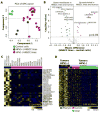Unraveling the oral cancer lncRNAome: Identification of novel lncRNAs associated with malignant progression and HPV infection
- PMID: 27424183
- PMCID: PMC5729891
- DOI: 10.1016/j.oraloncology.2016.05.014
Unraveling the oral cancer lncRNAome: Identification of novel lncRNAs associated with malignant progression and HPV infection
Abstract
Objectives: The role of long non-coding RNA (lncRNA) expression in human head and neck squamous cell carcinoma (HNSCC) is still poorly understood. In this study, we aimed at establishing the onco-lncRNAome profiling of HNSCC and to identify lncRNAs correlating with prognosis and patient survival.
Materials and methods: The Atlas of Noncoding RNAs in Cancer (TANRIC) database was employed to retrieve the lncRNA expression information generated from The Cancer Genome Atlas (TCGA) HNSCC RNA-sequencing data. RNA-sequencing data from HNSCC cell lines were also considered for this study. Bioinformatics approaches, such as differential gene expression analysis, survival analysis, principal component analysis, and Co-LncRNA enrichment analysis were performed.
Results: Using TCGA HNSCC RNA-sequencing data from 426 HNSCC and 42 adjacent normal tissues, we found 728 lncRNA transcripts significantly and differentially expressed in HNSCC. Among the 728 lncRNAs, 55 lncRNAs were significantly associated with poor prognosis, such as overall survival and/or disease-free survival. Next, we found 140 lncRNA transcripts significantly and differentially expressed between Human Papilloma Virus (HPV) positive tumors and HPV negative tumors. Thirty lncRNA transcripts were differentially expressed between TP53 mutated and TP53 wild type tumors. Co-LncRNA analysis suggested that protein-coding genes that are co-expressed with these deregulated lncRNAs might be involved in cancer associated molecular events. With consideration of differential expression of lncRNAs in a HNSCC cell lines panel (n=22), we found several lncRNAs that may represent potential targets for diagnosis, therapy and prevention of HNSCC.
Conclusion: LncRNAs profiling could provide novel insights into the potential mechanisms of HNSCC oncogenesis.
Keywords: Head and neck squamous cell carcinoma (HNSCC); Human papilloma virus (HPV); Long non-coding RNA; RNA-sequencing; TCGA; TP53.
Copyright © 2016 Elsevier Ltd. All rights reserved.
Conflict of interest statement
No conflicts of interest with the contents of this article.
Figures




Similar articles
-
Excavating novel diagnostic and prognostic long non-coding RNAs (lncRNAs) for head and neck squamous cell carcinoma: an integrated bioinformatics analysis of competing endogenous RNAs (ceRNAs) and gene co-expression networks.Bioengineered. 2021 Dec;12(2):12821-12838. doi: 10.1080/21655979.2021.2003925. Bioengineered. 2021. PMID: 34898376 Free PMC article.
-
Integrated analysis of lncRNA-associated ceRNA network in p16-positive and p16-negative head and neck squamous cell carcinoma.Medicine (Baltimore). 2022 Aug 19;101(33):e26120. doi: 10.1097/MD.0000000000026120. Medicine (Baltimore). 2022. PMID: 35984201 Free PMC article.
-
Identification of hub genes and potential therapeutic mechanisms related to HPV positive head and neck squamous carcinoma based on full transcriptomic detection and ceRNA network construction.Gene. 2024 Jun 5;910:148321. doi: 10.1016/j.gene.2024.148321. Epub 2024 Feb 28. Gene. 2024. PMID: 38428621
-
Role of non-coding RNAs in head and neck squamous cell carcinoma: A narrative review.Oral Dis. 2018 Nov;24(8):1417-1427. doi: 10.1111/odi.12782. Epub 2017 Nov 3. Oral Dis. 2018. PMID: 28941018 Review.
-
Expression of SESN1, UHRF1BP1, and miR-377-3p as prognostic markers in mutated TP53 squamous cell carcinoma of the head and neck.Cancer Biol Ther. 2017 Oct 3;18(10):775-782. doi: 10.1080/15384047.2017.1373212. Epub 2017 Sep 8. Cancer Biol Ther. 2017. PMID: 28886272 Free PMC article. Review.
Cited by
-
lncRNA in HNSCC: challenges and potential.Contemp Oncol (Pozn). 2017;21(4):259-266. doi: 10.5114/wo.2017.72382. Epub 2017 Dec 30. Contemp Oncol (Pozn). 2017. PMID: 29416430 Free PMC article. Review.
-
LncRNA WWTR1-AS1 upregulates Notch3 through miR-136 to increase cancer cell stemness in cervical squamous cell carcinoma.BMC Womens Health. 2024 Feb 8;24(1):104. doi: 10.1186/s12905-024-02905-7. BMC Womens Health. 2024. PMID: 38331752 Free PMC article.
-
Prevalence and Risk Factors of Human Papillomavirus in Male Patients: A Systematic Review and Meta-Analysis.Int J Environ Res Public Health. 2018 Oct 10;15(10):2210. doi: 10.3390/ijerph15102210. Int J Environ Res Public Health. 2018. PMID: 30309014 Free PMC article.
-
LncRNA PVT1 promotes the growth of HPV positive and negative cervical squamous cell carcinoma by inhibiting TGF-β1.Cancer Cell Int. 2018 May 8;18:70. doi: 10.1186/s12935-018-0567-2. eCollection 2018. Cancer Cell Int. 2018. PMID: 29760583 Free PMC article.
-
Current Status of Human Papillomavirus-Related Head and Neck Cancer: From Viral Genome to Patient Care.Virol Sin. 2021 Dec;36(6):1284-1302. doi: 10.1007/s12250-021-00413-8. Epub 2021 Jun 21. Virol Sin. 2021. PMID: 34152564 Free PMC article. Review.
References
Publication types
MeSH terms
Substances
Grants and funding
LinkOut - more resources
Full Text Sources
Other Literature Sources
Medical
Research Materials
Miscellaneous

